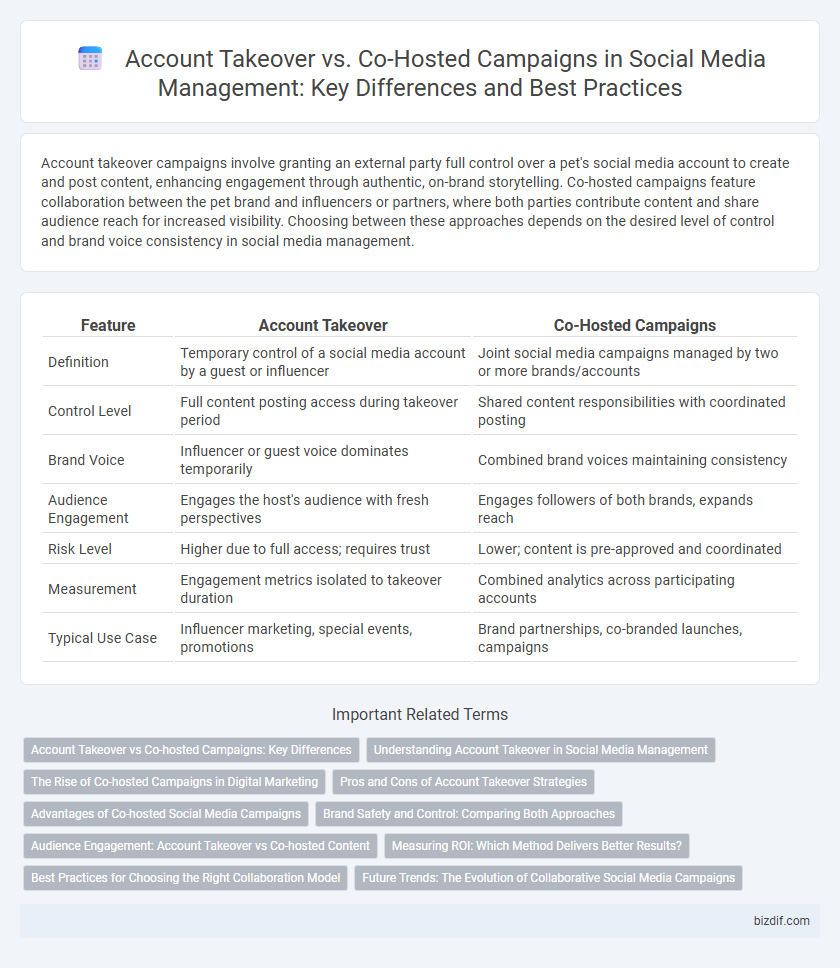Account takeover campaigns involve granting an external party full control over a pet's social media account to create and post content, enhancing engagement through authentic, on-brand storytelling. Co-hosted campaigns feature collaboration between the pet brand and influencers or partners, where both parties contribute content and share audience reach for increased visibility. Choosing between these approaches depends on the desired level of control and brand voice consistency in social media management.
Table of Comparison
| Feature | Account Takeover | Co-Hosted Campaigns |
|---|---|---|
| Definition | Temporary control of a social media account by a guest or influencer | Joint social media campaigns managed by two or more brands/accounts |
| Control Level | Full content posting access during takeover period | Shared content responsibilities with coordinated posting |
| Brand Voice | Influencer or guest voice dominates temporarily | Combined brand voices maintaining consistency |
| Audience Engagement | Engages the host's audience with fresh perspectives | Engages followers of both brands, expands reach |
| Risk Level | Higher due to full access; requires trust | Lower; content is pre-approved and coordinated |
| Measurement | Engagement metrics isolated to takeover duration | Combined analytics across participating accounts |
| Typical Use Case | Influencer marketing, special events, promotions | Brand partnerships, co-branded launches, campaigns |
Account Takeover vs Co-hosted Campaigns: Key Differences
Account takeover campaigns involve granting a third party full control of a social media account for a limited time, allowing authentic brand engagement and direct audience interaction. Co-hosted campaigns feature collaboration between multiple brands or influencers, sharing content creation and audience reach without transferring account access. The key difference lies in control: account takeovers centralize management under one guest, while co-hosted campaigns distribute content responsibilities across partners.
Understanding Account Takeover in Social Media Management
Account takeover in social media management occurs when unauthorized users gain control of a brand's social profiles, risking reputational damage and data breaches. This security threat often results from weak passwords, phishing attacks, or lack of multi-factor authentication, making robust cybersecurity measures essential. Unlike co-hosted campaigns that involve collaboration between brands for promotional content, account takeover compromises platform integrity and user trust, necessitating immediate detection and response protocols.
The Rise of Co-hosted Campaigns in Digital Marketing
Co-hosted campaigns have surged in digital marketing, offering brands a collaborative approach to amplify reach and engagement by leveraging multiple audiences simultaneously. Unlike account takeover strategies that involve temporarily controlling another brand's social media account, co-hosted campaigns facilitate joint content creation and shared promotion while maintaining individual account ownership. This trend enhances authenticity and trust, driving higher user interaction and ROI across platforms like Instagram, TikTok, and Facebook.
Pros and Cons of Account Takeover Strategies
Account takeover strategies in social media management offer brands enhanced authenticity by allowing influencers direct control over content, fostering higher engagement and trust. However, this approach carries risks such as potential loss of brand voice consistency, security vulnerabilities, and decreased control over messaging. Brands must weigh these benefits against the challenges of maintaining oversight and safeguarding account integrity when adopting takeover campaigns.
Advantages of Co-hosted Social Media Campaigns
Co-hosted social media campaigns amplify brand reach by leveraging the combined audiences of multiple partners, resulting in enhanced engagement and broader visibility. Shared resources and creative input lead to more diverse and compelling content, increasing the campaign's overall effectiveness. Collaborative efforts also foster stronger partnerships and trust between brands, boosting long-term customer loyalty and brand credibility.
Brand Safety and Control: Comparing Both Approaches
Account takeover campaigns grant full access to a brand's social media account, ensuring maximum control over content and immediate response to audience interactions, which enhances brand safety by minimizing risks of miscommunication or unauthorized posts. Co-hosted campaigns involve collaboration between two or more accounts while maintaining separate access, offering shared control but requiring strict coordination to preserve brand consistency and prevent conflicting messages. Prioritizing brand safety, account takeovers provide centralized oversight, whereas co-hosted campaigns rely on aligned strategies and clear communication protocols to mitigate risks.
Audience Engagement: Account Takeover vs Co-hosted Content
Account takeover campaigns drive higher audience engagement by offering authentic, behind-the-scenes access through a trusted influencer's personal connection, resulting in increased interaction and brand loyalty. Co-hosted campaigns leverage the combined audiences of multiple creators, expanding reach and encouraging cross-community engagement while maintaining diverse content perspectives. Both strategies optimize engagement metrics but differ in intimacy and scope, with account takeovers fostering deeper individual connections and co-hosted content emphasizing collaborative exposure.
Measuring ROI: Which Method Delivers Better Results?
Measuring ROI in social media management reveals that account takeover campaigns often deliver higher engagement rates and direct audience interaction, boosting brand visibility and conversion metrics. Co-hosted campaigns leverage combined follower bases and shared content, enhancing reach but sometimes diluting attribution of results between partners. Analyzing key performance indicators like click-through rates, follower growth, and conversion tracking provides clearer insight into which method yields superior ROI for specific campaign goals.
Best Practices for Choosing the Right Collaboration Model
Selecting the appropriate collaboration model involves evaluating brand alignment, audience engagement, and control over content. Account takeover campaigns offer authentic, real-time interactions by granting influencers temporary access to your social media, enhancing trust and reach. Co-hosted campaigns require joint content creation and shared promotion efforts, ensuring balanced brand exposure and cohesive messaging across all platforms.
Future Trends: The Evolution of Collaborative Social Media Campaigns
Account takeover and co-hosted campaigns are evolving into more integrated strategies in social media management, leveraging AI-driven analytics for enhanced audience targeting and engagement. Future trends indicate a shift towards seamless collaboration between brands and influencers through blockchain verification to ensure authenticity and transparency. This evolution supports dynamic content sharing across multiple platforms, maximizing reach and real-time interaction.
Account takeover vs Co-hosted campaigns Infographic

 bizdif.com
bizdif.com